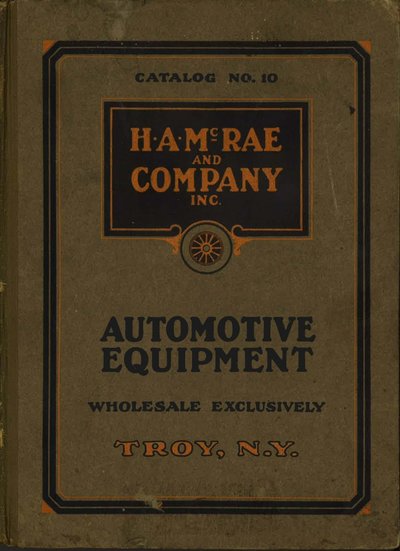Vintage Literature: antique tool and part catalogs

Photographs by the author.
Maybe you just picked up some obscure tool at a swap meet and are now wondering what it is. Perhaps the ahooga horn on your Model A is missing its identification plate, or you’re trying to decide what aftermarket components on your REO are period-correct. Possibly you’re an enthusiast of petroliana, spark plugs, or packaging and product display stands, and you want to see what’s missing from your collection. Or, heck, maybe you just like leafing through pages and pages of old tools, parts, car-care products, hardware, trinkets and doodads.
If any of this sounds familiar, track down an automotive equipment catalog like the one featured here. Of course, because they were typically used for a year or two and then discarded, the supply is spotty, though you’re likely to find at least a few at a swap meet, and you might even stumble across one in your local whatnot shop. Examples discovered in either of these kinds of locations are likely to be less expensive than those you will find on eBay, and you’ll have the benefit of being able to easily make sure they contain what you’re looking for.
However, if you’re like me, and locating a catalog from a particular year or specializing in a certain brand vehicle is important, the used-book seller’s online marketplace called abebooks.com or eBay might be your best bet. The example here is dated 1923 and sold for $39.99, plus shipping – which is a little steep – but the investment got me 279 heavy-weight, glossy, hardbound pages filled with…
…fascinating insights into the wide variety of automotive equipment that was being used in garages and private workshops in the time of the Model T.
From air compressors to vulcanizers, gas pumps to oil cans, drill presses to jacks and lifts, every tool listed in this wholesale catalog is accompanied by exceptional illustrations and extensive descriptions explaining the product’s uses as well as its features and cost to the salespeople who will be selling them. Retail catalogs – when they existed – likely have less meat-and-potatoes information, favoring instead whiz-bang marketing tactics aimed at charming the private customer.
Check out the Weaver Hi-Lift jack (above left). Though it utilizes a worm-and-gear mechanism to raise a vehicle and reliably hold it aloft, something about sitting under said vehicle perched in quite the way that this one is, without wheel chocks or brakes on the jack’s casters, just makes me cringe.
…soaps, polishes, waxes, greases, oils, grinding compounds, solvents, sealants, shellacs, enamels and varnishes galore.
Old favorites like Johnson’s wax and Havoline oil, as well as obscure brands like Se-Ment-Ol radiator cement and Mendall Metal pack the pages of these catalogs, tempting the automobiliac and the font-o-phile alike to seek out the last surviving examples of this rare ephemera tucked away in the backs of cabinets in falling-down garages everywhere.
…aftermarket parts like distinctive bumpers, radiator emblems, Motometers, dash clocks and lamps, spotlights and taillamps, and the aforementioned ahooga horns, too.
However, one thing to keep in mind with these catalogs is that even though they seem to be overflowing with products, they do not in fact contain everything that was available on the market at a given time.
Take that identity-plate-lacking horn, for example: To determine what model it is would require consulting multiple catalogs from the same era. Together, the H.A. McRae & Company Inc. catalog depicted here and my 1924 A-E Supply Company catalog (at bottom) present only three brands of horn—Klaxon, Sparton and Buell, and the Buells aren’t even electrically-driven ahoogas; rather, they’re of the cylinder-explosion single-tone type.
…brand-specific tools and replacement and aftermarket components.
The catalogs from H.A. McRae and A-E Supply both feature a section near the back containing Ford-specific items, ranging from replacement fenders to roller bearings, from dash-mounted oil gauges to Fat-Man-style folding steering wheels, and from “perch pushers” to long-handled petcock wrenches (so you don’t have to get down on your hands and knees to open the petcock to check the oil level, of course!).
The comprehensiveness of these brand-specific sections varies from resource to resource, with A-E offering a small assortment of the more commonly needed replacement components, like fenders and radiators, along with a smattering of specialized tools, and H.A. McRae providing almost everything one would need to construct an entire Model T from scratch.
…some interesting surprises.
Automotive parts and tool catalogs, like all old books, have had long lives and may have picked up some intriguing items along the way. Hand-drawn fabrication plans, parts lists, newspaper articles, love notes and paper currency may have been slipped between these pages to mark a spot or for safe keeping. Though maybe not quite as interesting as these, the above letter selling Chief auto mirrors was found crisply pressed in between the pages of my H.A. McRae catalog.
All of the wholesale catalogs I’ve seen include extensive indexes, making them especially useful when you’re not just whiling away the time turning the pages, but actually doing research. If it’s just an easy-to-use reference that you’re after, though, rather than an authentic antique automobile text, a few of these catalogs have been digitally scanned to computer disks, presumably with built-in search capabilities, and are available for a fraction of the price of the paper texts on eBay.
Finally, as your nightstand can undoubtedly attest, grunting under the stacked weight of your own current automotive parts and tools catalogs, these resources have only proliferated over the history of the automobile. So, even if your tastes run to vehicles more recent than the 1920s and ’30s, there are plenty of catalogs out there to suit you. For a great read on these more contemporary catalogs, including those featuring speed components, read Tom DeMauro’s article on the Hemmings blog.

